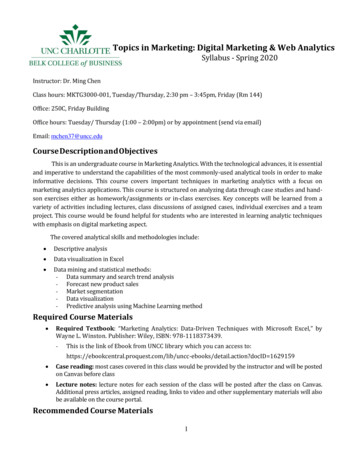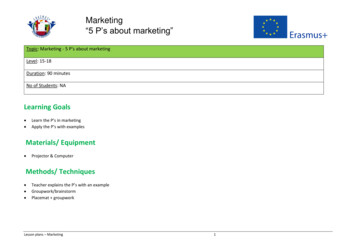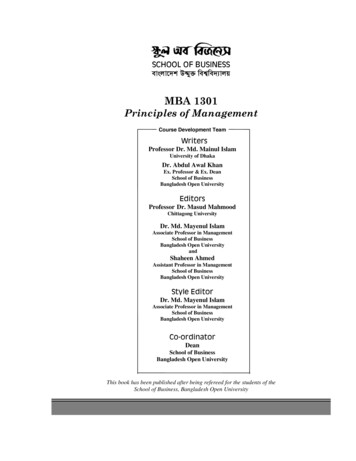
Transcription
MARKETING PRINCIPLESA Guide to Understanding the Basics of Marketing and Marketing Planning for GrowthMarketingPrinciplesA Guide to Understanding the Basics of Marketingand Marketing Planning for Growth1
MARKETING PRINCIPLESA Guide to Understanding the Basics of Marketing and Marketing Planning for Growth World Scout Bureau Inc.ManagementSeptember 2015World Scout Bureau Asia-Pacific Support Centre,Makati CityODC International Plaza Building219 Salcedo Street, Legaspi Village, Makati City1229, PhilippinesTel.: 63 2 818 0984 / 899 27 12Fax: 63 2 819 0093asia-pacific@scout.orgscout.orgReproduction is authorised to National ScoutOrganizations and Associations which aremembers of the World Organization of theScout Movement.2Credit for the source must be given.
MARKETING PRINCIPLESA Guide to Understanding the Basics of Marketing and Marketing Planning for GrowthMARKETING PRINCIPLESA Guide to Understanding the Basics of Marketingand Marketing Planning for Growth3
MARKETING PRINCIPLESA Guide to Understanding the Basics of Marketing and Marketing Planning for GrowthPREFACEThis short publication has been compiled to assist adult membersof Scouting in the Asia-Pacific Region gain a greater understandingof Marketing and to be able to apply those concepts and principlesin developing the Growth of Scouting in the Region.Topics covered can be identified from the Table of Contents thatfollows.An important first step in any marketing planning process is forthe organisation to have a clear understanding of its internalStrengths and Weaknesses, as well as the external Opportunitiesand Threats that exist currently or may develop in the foreseeablefuture.The analysis of this is called SWOT Analysis. It is also critical thatthese SWOT points be prioritised as normally such analysis willbring to light many different points for examination.The guide includes details on how to go about this analysis.For NSO’s any planning must also take account of World andRegional priorities already established in World and Regionalstrategies.The Mission of Scouting is an established principle on which allNSO’s should be basing their programs and activities.However the Management of individual NSO’s may find that theyneed to develop a Vision for the future of their NSO based onindividual circumstances. Having an inspirational and relevantVision that helps to energise management and members can bethe ‘glue” that drives cooperation and enthusiasm throughout theorganisation.4
MARKETING PRINCIPLESA Guide to Understanding the Basics of Marketing and Marketing Planning for GrowthSimilarly, the Marketing Concept spoken of in the publication,when embraced by the NSO provides a philosophy that cangenerate the engine for development and growth of Scouting. TheMarketing Concept is the philosophy that makes Scouting YouthMembers the focal point of all its activities.This is of course already an accepted philosophy of WOSM. Sothere is a natural fit between Scouting and the Marketing Concept.This Guide can be used by APR and NSO Adult Support andTraining Teams to develop Scouting specific and relevant trainingprograms and sessions.Richard MillerChairman, APR Scouting Profile Sub-Committee 2012-2015Acknowledgement: MarketingTeacher.com, a free website for marketing learningand teaching has been a valuable resource in compiling this booklet –www.marketingteacher.com5
MARKETING PRINCIPLESA Guide to Understanding the Basics of Marketing and Marketing Planning for GrowthTABLE OF CONTENTSWHAT IS MARKETING?Some basic definitions of marketingThe Philosophy of the Marketing Concept9CONSUMER BUYER BEHAVIOUR12THE ADOPTION PROCESS15THE MARKETING MIXWhat is the marketing mix?17PRODUCT AS AN ELEMENT OF THE MARKETING MIXStrategies for the differing stages of the Product Life CycleIntroductionGrowthMaturityDeclineIssues with Product Life CycleThree levels of a product18PRICE AS AN ELEMENT OF THE MARKETING MIXPremium PricingPenetration PricingEconomy PricingPrice SkimmingPsychological PricingProduct Line PricingOptional Product PricingCaptive Product PricingProduct Bundle PricingPromotional PricingGeographical PricingValue Pricing22PLACE AS AN ELEMENT OF THE MARKETING MIX25There are six basic ‘channel’ decisionsSelection Consideration - how do we decide upon a distributor?Types of Channel IntermediariesChannel Intermediaries - WholesalersChannel Intermediaries - RetailersChannel Intermediaries – Internet/On-Line-Sales6
MARKETING PRINCIPLESA Guide to Understanding the Basics of Marketing and Marketing Planning for GrowthPROMOTION AS AN ELEMENT OF THE MARKETING MIXThe Marketing Communications MixThe Loyalty LadderTurning a prospect into an advocatePersonal SellingStage One - ProspectingStage Two - Making First ContactStage Three - The Sales Call (or Sales Presentation)Stage Four - Objection HandlingStage Five - Closing the SaleSales PromotionPublic Relations (PR)Interviews and photo-callsSpeeches, presentations and speech writingCorporate literature e.g. financial reportsDirect MailTrade Fairs and ExhibitionsAdvertisingPlanning for advertisingSponsorshipeMarketingWhat are the e-Marketing tools?SERVICES MARKETING AND THE EXTENDED MAKETING MIX(7P’s)The 7P’s of the Services Marketing Mix‘People’ as part of the Marketing MixTrainingCustomer ServiceProcess as an element of the Marketing MixPhysical Environment as an element of the Marketing DUCTION TO MARKETING RESEARCHSources of Data - Primary and SecondaryPrimary Marketing ResearchInterviewsTelephone InterviewFace-to-face InterviewsThe Internet567
MARKETING PRINCIPLESA Guide to Understanding the Basics of Marketing and Marketing Planning for GrowthMail SurveyMystery ShoppingFocus GroupsProduct testsDiariesOmnibus StudiesSecondary Marketing Research, or “Desk” ResearchINTRODUCTION TO BRANDSBrands and BrandingFour Key Pillars of Branding63SWOT ANALYSIS66Strengths and Weaknesses are Internal FactorsOpportunities and Threats are External FactorsSimple Rules for Successful SWOT AnalysisA more advanced SWOT analysisWhy is there a need for an advanced approach to SWOTAnalysis?Personal experienceClearly defining strengths or weaknesses, opportunitiesor threats.Emphasise detailWeightingRank and prioritise8THE MARKETING AUDITThe Internal Marketing EnvironmentThe External Marketing EnvironmentA Review of the Current Marketing Plan73MARKETING PLANNINGStage One - Situation Analysis (and Marketing Audit)Stage Two - Set “Smart” Marketing ObjectivesStage Three - Describe the Target MarketStage Four - Marketing TacticsStage Five - Marketing Controls76
MARKETING PRINCIPLESA Guide to Understanding the Basics of Marketing and Marketing Planning for GrowthWHAT IS MARKETING?Some basic definitions of marketing.Marketing can be described as any “exchange” activity intended tosatisfy human needs and wants.There are many definitions of marketing. The more appropriatedefinitions are focused upon customer orientation and satisfactionof customer needs.For example: Marketing is the social process by which individualsand groups obtain what they need and want through creating andexchanging products and value with others - Kotler.Marketing is the management process that identifies, anticipatesand satisfies customer requirements profitably - The CharteredInstitute of Marketing (CIM).The CIM definition looks not only at identifying customer needs,but also satisfying them (short-term) and anticipating them in thefuture (long-term retention).The right product, in the right place, at the right time, at the rightprice - Adcock.This is a snappy and realistic definition that uses McCarthy’s FourPs.Marketing is essentially about marshalling the resources ofan organization so that they meet the changing needs of thecustomer on whom the organization depends - Palmer.This is a more recent and very realistic definition that looks atmatching capabilities with needs.9
MARKETING PRINCIPLESA Guide to Understanding the Basics of Marketing and Marketing Planning for GrowthThe Philosophy of the Marketing Concept.The academic discipline of marketing has core schools ofthought, where marketing is seen as either a philosophy or asa function. Where marketing is considered a philosophy, themarketing concept is embedded in management thought. Withthe alternative view, where marketing is a function within abusiness, marketing is seen as a department, in the same way asaccounting or personnel.Marketing is not only much broader than selling, it is not aspecialized activity at all but it encompasses the entire business.It is the whole business seen from the point of view of the finalresult, that is, from the customer’s point of view. Concern andresponsibility for marketing must therefore permeate all areas ofthe enterprise - Drucker.For Scouting, it is seeing the whole of Scouting from the member’spoint of viewThe marketing concept is a philosophy, not a system of marketingor an organizational structure. It is founded on the belief thatprofitable sales and satisfactory returns on investment can onlybe achieved by identifying, anticipating and satisfying customerneeds and desires - Barwell.It makes the customer, and the satisfaction of his or her needs,the focal point of all the organisation’s activities. It is driven bysenior managers, passionate about delighting their customers.Implementation of marketing has traditionally required attentionto three basic elements of the marketing concept. These are:Customer orientation; An organization to implement a customerorientation; Long-range customer and societal welfare.10
MARKETING PRINCIPLESA Guide to Understanding the Basics of Marketing and Marketing Planning for GrowthNow that some definitions of marketing and the marketingconcept have been introduced, the important elements containedare as follows: Marketing focuses on the satisfaction of customer needs,wants and requirements. The philosophy of marketing needs to be owned by everyonefrom within the organization. Future needs have to be identified and anticipated. There is normally a focus upon profitability, especially in thecorporate sector. However, as public sector organizations andnot-for-profit organizations adopt the concept of marketing,this need not always be the case. More recent definitions recognize the influence of marketingupon society.11
MARKETING PRINCIPLESA Guide to Understanding the Basics of Marketing and Marketing Planning for GrowthCONSUMER BUYER BEHAVIOURIf a marketer can identify consumer buyer behaviour, he or shewill be in a better position to target products and services atthem. Buyer behaviour is focused upon the needs of individuals,groups and organisations.It is important to understand the relevance of human needs tobuyer behaviour (remember, marketing is about satisfying needs).Self-ActualisationEsteem NeedsSocial NeedsSecurity NeedsPhysiological NeedsAbraham Maslow’s Hierarchy of NeedsFig 1.Abraham Maslow represented human motivations by his hierarchyof needs: The hierarchy is triangular. This is because as you moveup it, fewer and fewer people satisfy higher level needs. We beginat the bottom level.The model is a little simplistic but introduces the concept ofdiffering consumer needs quite well.Physiological needs such as food, drink, shelter, air, water, heat,12
MARKETING PRINCIPLESA Guide to Understanding the Basics of Marketing and Marketing Planning for Growthand the basic necessities of survival need to be satisfied first.At the second level of Security needs; Needs for safety, protectionand order, a place to live that protects from the elements andpredators.At the third level, Social needs; we meet our social andbelongingness needs i.e. need for love, affection, belonging to agroup and acceptance.The final two levels are esteem and self-actualisation. Fewerpeople satisfy the higher level needs.Esteem Needs; need for self-respect, reputation, prestige, status,achieving something that makes one recognised and givespersonal satisfaction, for example writing a book.Self-actualisation; need for self-fulfilment. Here a person is one ofa small number to actually do some particular thing. For example,Neil Armstrong self-actualised as the first man to walk on themoon.To understand consumer buyer behaviour is to understand howthe person interacts with the marketing mix. The Marketing Mixinputs (or the four P’s of price, place, promotion, and product)are adapted and focused upon the target market (consumer) asrepresented in the model below.13
MARKETING PRINCIPLESA Guide to Understanding the Basics of Marketing and Marketing Planning for chaseDecisionsCONSUMERProduct ChoiceLocation ChoiceBranch ChoiceOther erceptionBuyer Decision ProcessBased on Cohen (1991)Fig 2.The psychology of each individual considers the product orservice on offer in relation to their own culture, attitude, previouslearning, and personal perception. The consumer then decideswhether or not to purchase, where to purchase, the brand that heor she prefers, and other choices.14
MARKETING PRINCIPLESA Guide to Understanding the Basics of Marketing and Marketing Planning for GrowthTHE ADOPTION PROCESSThe Adoption Process (also known as the Diffusion of Innovation) ismore than fifty years old. It was first described by Bourne (1959), soit has stood the test of time and remained an important marketingtool ever since. It describes the behaviour of consumers as theypurchase new products and services. The individual categories ofinnovator, early adoptor, early majority, late majority and laggardsare described below.Fig 3.IInnovators are the first to adopt and display behaviour thatdemonstrates that they are likely to want to be ahead, and to bethe first to own new products, well before the average consumer.They are often not taken seriously by their peers. They oftenbuy products that do not make it through th
Similarly, the Marketing Concept spoken of in the publication, when embraced by the NSO provides a philosophy that can generate the engine for development and growth of Scouting. The Marketing Concept is the philosophy that makes Scouting Youth Members the focal point of all its activities.











